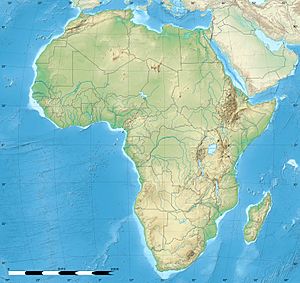Bou Craa facts for kids
Quick facts for kids
Bou Craa
Bucraa
|
|
|---|---|

View of Bou Craa phosphate mine from space, taken in 2018
|
|
| Non-Self-Governing Territory | Western Sahara |
| Region | Laâyoune-Sakia El Hamra |
| Province | Laâyoune |
| Claimed by | |
| Controlled by | |
| Area | |
| • Total | 211.62 km2 (81.71 sq mi) |
| Population
(2004)
|
|
| • Total | 2,519 |
| • Density | 11.9/km2 (4.59/sq mi) |
| Time zone | UTC0 (Africa/El_Aaiun) |
Bou Craa (also called Bo Craa or Bu Craa) is a town in Western Sahara. It is located south-east of the main city of El Aaiún. This town is mostly home to people who work for a company called Phosboucraa. This company is a part of Morocco's OCP Group, and it mines a special rock called phosphate.
What is Bou Craa Known For?
Bou Craa is famous for having a huge amount of phosphate rock underground. There are over 1.7 billion tons of it! Phosphate is a very important mineral. It is used to make fertilizers for farms. This helps plants grow better.
Mining operations in Bou Craa started in 1972. This means people began digging up the phosphate rock then.
History of the Mine
During the time when Spain controlled this area, many workers at the phosphate mines joined groups that wanted independence for Western Sahara. These groups included the Movement for the Liberation of Saguia el Hamra and Wadi el Dhahab and the Polisario Front.
In April 1976, Bou Craa became part of the area controlled by Morocco. This happened after an agreement called the Madrid Accords. Mining stopped for a while in 1976. This was because of attacks by the Polisario Front.
During the Western Sahara War, the Polisario Front tried to stop the phosphate from being transported. These attacks mostly stopped in the early 1980s. This was when the town became protected by the Moroccan Wall. This wall helped Morocco control the north-western part of Western Sahara. Mining started again in July 1982, but on a smaller scale.
The Longest Conveyor Belt
Today, the mine produces about 3 million tons of phosphate each year. This is about 10% of all the phosphate produced in Morocco. The phosphate is moved from the mine to the coast using a very long conveyor belt.
This conveyor belt is about 100 kilometres (62 mi) long. It is the longest conveyor belt in the world! Dust from the belt is so much that it can even be seen from space.
See also
 In Spanish: Bucraa para niños
In Spanish: Bucraa para niños



